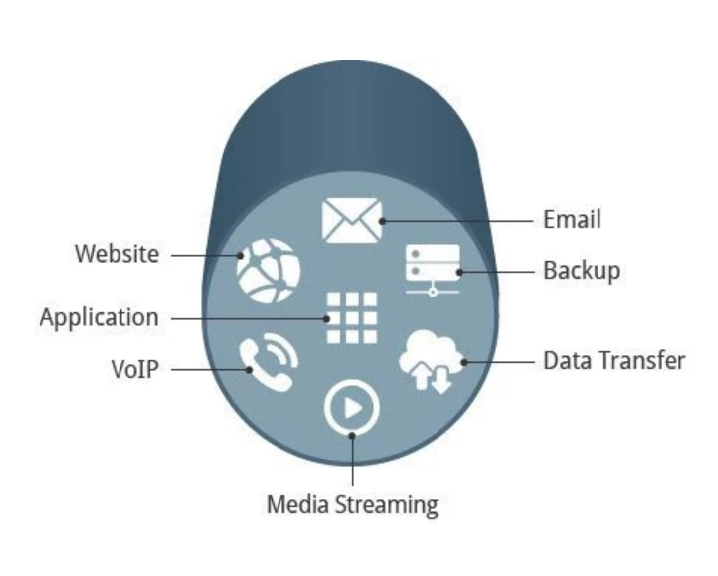Videos: SD-WAN vs MPLS Network Technology Explained
In this post we take a look at two different network technologies; SD-WAN vs MPLS. Both are still widely used in networking today. There’s a lot of different opinions out there on which is better. A Software Defined Wide Area Network (SD-WAN for short), is certainly the latest of the two services. Whereas the history of MPLS (Multi Protocol Level Switching) dates back to the early 1990’s.
- Which has the better performance for your network?
- What are the connectivity requirements of each?
- Which has better security?
All good questions. We have two explainer videos below to answer those questions and more. Let’s take a look. Here’s an explainer video from Pat Herron at Chicago based TMSP Nitel. In the below video, Pat takes an objective looks at MPLS vs SD-WAN, as network solutions.
Video transcript: Thanks for joining this segment of From the Guys in Orange. I’m Pat Herron, the Vice President of Product Management here at Nitel. From the Guys in Orange is a video series we’re putting together to help our partners and their customers learn a little bit more about the topics of networking.
One of the questions we get asked quite a bit is, “Will SD-WAN replace MPLS as the leading network technology?” A lot of agenda and a lot of voices and a lot of opinions on this topic. But we’re going to look into some facts. What makes an MPLS network or an SD-WAN network? What are the features that make one more compelling than the other?
That’s how we’re going to spend our time today. To provide a framework for this discussion, let’s assume that the MPLS network is being provided on one circuit by a service provider over a carrier-grade private network with a typical service level agreement. It’s also assumed that the SD-WAN is being provided over two internet circuits. One, a carrier-grade dedicated internet service and the other cable provider broadband internet service.
SD-WAN vs MPLS: Which Has Better Packet Delivery?
In order for any application to work, the data packets that make up that application have to get to their destination. A carrier-grade MPLS network will offer packet delivery in the 99.9 percent range, meaning that only one in a thousand packets is lost in transit. This is typically backed up with a Service Level Agreement that puts money behind that performance metric. Data delivered over the public internet typically can have one percent or more packet loss, meaning that over one in a hundred packets may be lost along the way.
A few broadband providers offer meaningful Service Level Agreements for packet loss and during times of heavy network congestion, they may even have higher levels of packet loss, which makes having two or more internet connections super important for an SD-WAN solution.
The SD-WAN solution, depending on the technology and the service provider delivering it like Nitel, can use methods to mitigate packet loss over the SD-WAN. Methods like Forward Error Correction that inserts parity bits into packets and those parity packets into the data flow allow for the SD-WAN to recover packets that may be lost along the way. So net-net. An SD-WAN solution, if designed well and implemented correctly, can offer packet delivery on par or at least very close to what an MPLS network can provide.
Application Prioritization and Performance: MPLS vs SD-WAN
Let’s turn our attention to application prioritization and performance. One of the benefits of having a private data network is that you get to prioritize which applications are going to flow over the shared resources and in that way, you can assure that applications will perform well. An MPLS network can offer three or four or even seven queues. These are priority tiers into which applications are mapped. The challenge for the network administrator is to identify and tag those applications and then map them into the appropriate queues and approach what we call “quality of service” or QOS.
This tagging and mapping can be both challenging and cumbersome. But it’s a proven approach that IT professionals know and rely upon. On an MPLS network, the quality of service is honored from end to end on the network so that the prioritization that goes in on one end is honored throughout the network and then still honored at the far end. This is very reliable and IT pros really like that level of reliability. An SD-WAN solution may offer dozens of queues into which applications can be prioritized and SD-WANs come with tools that allow for the identification of hundreds, even thousands of applications which really simplifies the mapping of those applications into queues.
This makes the task of prioritizing applications for the SD-WAN network a lot simpler both to set up and to make changes. Plus an SD-WAN solution with a good analytics and reporting platform can provide the IT pro with clear visibility at each application’s performance. As good as this sounds, when an SD-WAN prioritizes applications to be carried over the internet, they’re prioritized when they’re leaving on one end. Then they’re subject to the worldwide wide web which may not mean those packets are still in the same order when they arrive at the far end.
So what’s the net-net? Application, prioritization and performance is more guaranteed on an MPLS network than they are on an SD-WAN solution. But an SD-WAN solution provides a lot more tools and can make the act of prioritization a lot simpler.

Example MPLS application and service prioritization by Fastmetrics
SD-WAN vs MPLS Reliability
Let’s turn to reliability. There’s a short story on this one. Two circuits are going to be more reliable than one. Many businesses back up their MPLS networks using a failover solution to an internet connection using DGP and a VPN to then regain access to that private network.
The challenge with this approach is that businesses are paying for backups that they don’t really have much of a use. They’re not always tested and may not work as expected when the time comes. Even if they do, it takes a little while to fail over. So session-based applications like phone calls could be interrupted. The SD-WAN solution relies on multiple internet access links and is fully aware of the condition of those access links at any given point in time. Not just hard-down conditions but also degradation of circuit quality.
High priority applications can be routed over the best available path at any moment, including the moment one of the access links fails. Depending on the SD-WAN solution design, like the ones from Nitel, even a phone call will not be interrupted. So net-net, the SD-WAN solution provides a simple and powerful way to improve application reliability.
Is SD-WAN or MPLS More Secure?
Let’s turn our attention to security. MPLS networks are considered secure because only MPLS nodes that are reading the packet labels destined for that node can see the contents of the packets and the MPLS network is provided by one trusted service provider. So even though it uses shared network resources, businesses have relied on MPLS to provide secure site-to-site communication for years. SD-WAN creates a secure tunnel for packets to traverse between sites of the network using a form, a virtual private networking connection, such as IP sec.
Since there are multiple paths between the sites, traffic can be distributed across the paths, making snooping even more difficult. So even though it’s riding over the public internet, the SD-WAN provides proven methods to keep the application traffic secure and depending on the SD-WAN provider, additional network security services can be layered on top of the SD-WAN service.
For example here at Nitel, we offer a next generation firewall and a unified threat management service on the same platform, the same hardware and the same portal as our SD-WAN service. This really adds to simplicity. It can improve cost performance. So net-net, is SD-WAN or MPLS more secure? Both employ proven methods to keep customer and business data secure.
Will SD-WAN Replace MPLS?
So will MPLS be replaced by SD-WAN and if so, when? A recent market survey done by a leading global cloud network provider found that 29% of IT leaders indicate that their companies have deployed or considering deploying SD-WAN in the next 12 months. Plus 30% more are considering SD-WAN but don’t have a date in mind. But what’s really interesting is that of those, 62% report MPLS investments will increase or remain unchanged over the next 12 to 24 months and 53% expect their SD-WAN deployments are going to drive increases in their investment in network security.
So what’s the upshot? The move towards software-defined networking is undeniable. The growth rate and adoption over the coming years will be accelerating. But that doesn’t mean that MPLS is going away anytime soon. It’s a tried and true technology that’s relied upon the world over by IT professionals and it’s going to be around for years to come.
Hopefully this video provided you with a little bit of information about how software-defined networking is shaping our marketplace and I hope that you check back frequently to Nitel’s YouTube Channel to find out more from The Guys in Orange.
SD WAN vs MPLS Explainer Video
In the below video, Australian based business fibre and network service company Vocus, takes a look at SD WAN vs MPLS services. Like many services, some things are a better fit for specific use cases. There’s pros and cons to each. Take a look;
Video transcript: An SD-WAN service connects business locations through multiple network providers across any distance. Regardless of the type of service, whether it’s an MPLS or broadband or 4G, an SD-WAN can aggregate them all to create a single seamless connection that provides greater control.
The latest developments in SD-WAN offer a lot of benefits for businesses that have challenges with their remote networks or need traffic prioritization. But while SD-WAN has clear benefits, smart companies and proceeding cautiously and with good reason. Your business and your employees need to be ready for SD-WAN. And only an expert network provider can guide you through that process. Transitioning to a network that uses both physical and virtualized technologies requires specialized knowledge. And understanding exactly what you want out of using a hybrid network like this is critically important.
What are you trying to achieve? How would the change impact your team structure? How will it affect your everyday processes?
You may find that just the process of re-architecting to a smarter network can solve your problems without the capital costs and projects risks. On top of this, because SD-WAN moves the responsibility of service to the customer and away from the carrier, any SLAs for your network can be easily compromised when routing is bypassed via SD-WAN. There is definitely a place for SD-WAN when it’s properly defined and architected.
The support for multitenancy, scalability, and improved access to cloud-based applications are very compelling benefits. As is the built-in automatic failover, dynamically replacing a lost connection with the best option to get the fastest, most stable solution.
So while SD-WAN isn’t a catch-all replacement and has major business changes to consider, it’s a great option for specific used cases. And when implemented correctly, can offer very handy benefits. If you have any more questions think your business could benefit from better WAN solutions, give us a call and we will be happy to help you however we can.
The Pros and Cons of SD-WAN and MPLS
In the next video, Robert Sturt – Managing Director of The Network Union, talks about the high level pros, cons and differences between MPLS vs SD-WAN via the Eye on Tech channel. With the key point being that there’s a place for both in network architecture, depending on requirements and expected outcomes.
Video transcript: Hi, I’m Robert Sturt from The Network Union. In this video, I’m going to talk about the high level differences of MPLS versus SD-WAN. The first point to make is that SD-WAN doesn’t have to be an internet technology. Providers and vendors support software WAN functionality with any connectivity time, which of course, includes MPLS. With this said, it is fair to say certain vendors such as Meraki, well, they are kind of much more relying to internet-based services.
Now, you no doubt have read the MPLS is deemed finished, dead, and all kinds of depressing stuff. But the reality is that private-based WAN services should and do form a component of a good network architecture.
The SD-WAN internet-based VPN positives are clear. Using the internet or public IP backbone means our cloud-based applications are much more accessible. Secure internet means our users can connect securely from wherever they are located on a global basis. And of course, there’s that cost-saving element. Using the internet often results in a significant price reduction versus MPLS.
Now, if you start comparing MPLS versus the flexibility and agility of internet-based SD-WAN, well, you’ll start to really get the idea why is it easy for SD-WAN providers to talk about MPLS as that older, more expensive technology. You will read a significant amount of content on various blogs stating how MPLS is in decline because it is so expensive and restrictive.
In short, companies are adopting SD-WAN primarily for cost-saving but also, internet-based resilience. So think of 4G and 5G when it’s available, broadband and so on, and of course public-based kind of applications. But there are other major benefits such as granular reporting, the ability to self-manage services, granular security and application performance training, which vendors and providers are saying is so good, you just simply do not require the end-to-end cost of MPLS.
Your IT team needs to understand the fundamental differences here. An MPLS circuit typically offers an end-to-end SLA that includes latency and jitter performance as a proper business SLA with the ability to protect your application traffic using quality of service. And you just don’t get those kind of guarantees using the internet.
The fact is the internet is much more robust and scalable versus even a few years ago. So it’s now very much a viable platform for sending mission-critical and delay-sensitive application traffic from site to site.
So that MPLS cost argument while it starts to lose its appeal, perhaps an overlooked area is support. So remember, those cost-savings using the internet, we’ve got to think about the difference between internet-based support, fixed times, and the support times we used to have with MPLS. When the service is in an outage situation, would you rather deal with a network operation center supporting MPLS or are you willing to put the business at risk by dealing with that cheap and cheerful ISP even if it is fronted by an SD-WAN provider?
Now of course, it isn’t fair to say that all ISP services do not offer good support, but remember the lower end of the market in respect of cost maybe somewhat different to the MPLS support that you are used to.
The global enterprise also needs to consider the performance of internet as a backbone between continents. So where possible, a single global public IP backbone will offer good end-to-end performance. But using multiple ISPs to save money could put in a whole world of pain as your traffic traverses those multiple ISPs and suffers poor latency and jitter performance, and not to mention support.
So SD-WAN, while it represents a here and now and the future of networking all at once, but remember, a good hybrid architecture can encompass all that SD-WAN offers and MPLS can be another component of your WAN. It is as ever about aligning your business requirements with the right service across technical, across strategy and support, and budget. So check with your prospective SD-WAN provider or vendor on how they can integrate MPLS into your overall architecture.




